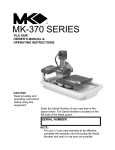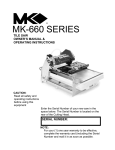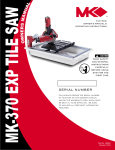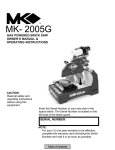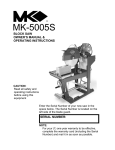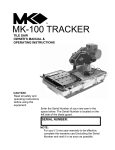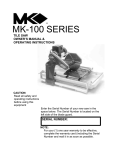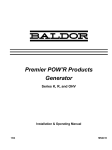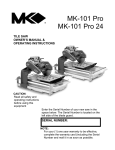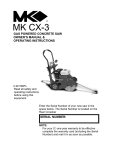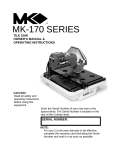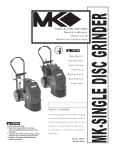Download MK Diamond Products MK-2000 PRO Series Owner`s manual
Transcript
MK-2000 PRO SERIES BRICK SAW OWNER’S MANUAL & OPERATING INSTRUCTIONS CAUTION: Read all safety and operating instructions before using this equipment Enter the Serial Number of your new saw in the space below. The Serial Number is located on the left side of the blade guard. SERIAL NUMBER: NOTE: For your (1) one year warranty to be effective, complete the warranty card (including the Serial Number and mail it in as soon as possible. INTRODUCTION We at MK Diamond want to congratulate you on selecting the MK-2000 PRO Brick Saw. We are certain that you will be pleased with your purchase. MK Diamond takes pride in producing the finest products in the industry. Operated correctly, your MK-2000 PRO should provide you with years of quality service. In order to help you, we have included this manual. This owners manual contains information necessary to operate and maintain your MK-2000 PRO safely and correctly. Please take a few minutes to familiarize yourself with the MK-2000 PRO by reading and reviewing this manual. If you should have questions concerning your MK-2000 PRO, please feel free to call our friendly customer service department at: 800 421-5830 Regards, MK Diamond MK-2000 Pro Revision 01/02, Effective Date January 10, 2002 Page 2 TABLE OF CONTENTS Page SAFETY: Safety Messages Damage Prevention Message General Safety Precautions and Hazard Symbols California Proposition 65 Message Electrical Requirements and Grounding Instructions Safety Label Locations Brick Saw Specific Warnings Product Specifications 4 4 4 6 7 9 9 10 UNPACKING, TRANSPORT, UNIVERSAL STAND, and ASSEMBLY Unpacking Contents Transport Universal Stand Assembly 11 11 11 12 12 SETUP, ADJUSTMENT AND OPERATION Setup Adjustment and Operation Cleanup 15 18 23 MAINTENANCE AND TROUBLESHOOTING Maintenance Troubleshooting 25 33 EXPLODED VIEW AND PARTS LIST Exploded View Parts List 37 38 THEORY Theory of Diamond Saws 43 ACCESSORIES Accessories 44 ORDERING and RETURN INSTRUCTIONS Ordering Information Return Material Policy Packaging Instructions Authorized Service Centers 45 45 45 45 Manual Part No. 158753 MK-2000 Pro Revision No. 01/02 Revision 01/02, Effective Date January 10, 2002 Page 3 SAFETY Read and follow all safety, operating and maintenance instructions. Failure to read and follow these instructions could result in injury or death to you or others. Failure to read and follow these instructions could also result in damage and/or reduced equipment life. SAFETY MESSAGES: Safety messages inform the user about potential hazards that could lead to injury, death and/or equipment damage. Each safety message will be preceded by one of the following (3) three words that identify the severity of the message. Not following instructions WILL lead to DEATH or SERIOUS INJURY Not following instructions COULD lead to DEATH or SERIOUS INJURY Not following instructions CAN lead to injury DAMAGE PREVENTION AND INFORMATION MESSAGES: A Damage Prevention Message is to inform the user of important information and/or instructions that could lead to equipment or other property damage if not followed. Information Messages convey information that pertains to the equipment being used. Each message will be preceded by the word NOTE, as in the example below. NOTE: Equipment and/or property damage may result if these instructions are not followed. GENERAL SAFETY PRECAUTIONS AND HAZARD SYMBOLS: In order to prevent injury, the following safety precautions and symbols should be followed at all times! Safety Precautions: KEEP GUARDS IN PLACE. In order to prevent injury, keep guards in place and in working order at all times. REMOVE ADJUSTING KEYS AND WRENCHES. Form a habit of checking to see that keys and adjusting wrenches are removed from the power tool before it is turned on. KEEP WORK AREA CLEAN. Cluttered work areas and benches invite accidents. DO NOT USE IN DANGEROUS ENVIRONMENTS. Do not use power tools in damp or wet locations nor expose them to rain. Always keep the work area well lighted. KEEP CHILDREN AWAY. All visitors and children should be kept a safe distance from work area. MAKE THE WORKSHOP KID PROOF. Make the workshops kid proof by using padlocks, master switches or by removing starter keys. DO NOT FORCE THE TOOL. A power tool will do a job better and safer operating at the rate for which it was designed. USE THE RIGHT TOOL. Do not force a tool or an attachment, to do a job that it was not designed to do. MK-2000 Pro Revision 01/02, Effective Date January 10, 2002 Page 4 SAFETY USE THE PROPER EXTENSION CORD. If using an extension cord make sure it is in good condition first. When using an extension cord, be sure to use one heavy enough to carry the current your product will draw. An undersized cord will cause a drop in line voltage that will result in a loss of power and overheating. TABLE 1, Page shows the correct AWG size to use depending on cord length and nameplate ampere rating. If in doubt, use the next heavier gage. The smaller the gage number, the heavier the cord. WEAR PROPER APPAREL. Do not wear loose clothing, gloves, neckties, rings, bracelets, or other jewelry that may be caught in moving parts. Non-slip footwear is recommended. Wear protective hair covering to contain long hair. ALWAYS USE SAFETY GLASSES. Safety glasses should always be worn when working around power tools. In addition, a face, dust mask or respirator should be worn if a cutting operation is dusty. Everyday eyeglasses only have impact resistant lenses and may not prevent eye injury-they are NOT safety glasses. SECURE WORK. Clamps or a vise should be used to hold work whenever practical. Keeping your hands free to operate a power tool is safer. DO NOT OVERREACH. Keep proper footing and balance at all times by not overreaching. MAINTAIN TOOLS WITH CARE. Keep tools clean for the best and safest performance. Always follow maintenance instructions for lubricating, and when changing accessories. DISCONNECT TOOLS. Power tools should always be disconnected before servicing or when changing accessories, such as blades, bits, cutters, and the like. REDUCE THE RISK OF UNINTENTIONAL STARTING. Make sure the ON/Off switch; is in the OFF position before plugging in a power tool. USE RECOMMENDED ACCESSORIES. Consult the owner's manual for recommended accessories. Using improper accessories may increase the risk of personal or by-stander injury. NEVER STAND ON THE TOOL. Serious injury could occur if a power tool is tipped, or if a cutting tool is unintentionally contacted. CHECK FOR DAMAGED PARTS. Before using a power tool, check for damaged parts. A guard or any other part that is damaged should be carefully checked to determine it would operate properly and perform its intended function. Always check moving parts for proper alignment or binding. Check for broken parts and mountings and all other conditions that may affect the operation of the power tool. A guard, or any damaged part, should be properly repaired or replaced. DIRECTION OF FEED. Always feed work into a blade or cutter against the direction of rotation. A blade or cutter should always be installed such that rotation is in the direction of the arrow imprinted on the side of the blade or cutter. NEVER LEAVE A TOOL RUNNING UNATTENDED – TURN POWER OFF. Do not leave a tool until it comes to a complete stop. Always turn a power tool OFF when leaving the work area, or, when a cut is finished. MK-2000 Pro Revision 01/02, Effective Date January 10, 2002 Page 5 SAFETY Hazard Symbols: ELECTRICAL SHOCK! Never touch electrical wires or components while the motor is running. Exposed, frayed or worn electrical motor wiring can be sources of electrical shock that could cause severe injury or burns. ACCIDENTAL STARTS! Before plugging the equipment into an electrical outlet, be sure the ON/OFF switch, is in the OFF position to prevent accidental starting. Unplug the power tool before performing any service operation. ROTATING OR MOVING PARTS! Keep hands, feet, hair, and clothing away from all moving parts to prevent injury. Never operate a power tool with covers, shrouds, or guards removed. Sawing and drilling generates dust. Excessive airborne particles may cause irritation to eyes, skin and respiratory tract. To avoid breathing impairment, always employ dust controls and protection suitable to the material being sawed or drilled; See OSHA (29 CFR Part 1910.1200). Diamond Blades improperly used are dangerous. Comply with American National Standards Institute Safety Code, B7.1 and, Occupational Safety and Health Act covering Speed, Safety Guards, Flanges, Mounting Procedures, General Operating Rules, Handling, Storage and General Machine Conditions. CALIFORNIA PROPOSITION 65 MESSAGE: Some dust created by power sanding, sawing, grinding, drilling, and other construction activities contain chemicals known [to the State of California] to cause cancer, birth defects or other reproductive harm. Some examples of these chemicals are: • Lead, from lead-based paints • Crystalline silica, from bricks and cement and other masonry products and • Arsenic and chromium, from chemically treated lumber For further information, consult the following sources: http://www.osha-slc.gov/sltc/silicarystalline/index.html http://www.oehha.org/prop65/out_of_date/6022kLstA.html Your risk from these exposures varies depending on how often you do this type of work. To reduce your exposure to these chemicals, work in a well-ventilated area, and work with approved safety equipment, such as those dust masks that are specially designed to filter out microscopic particles. MK-2000 Pro Revision 01/02, Effective Date January 10, 2002 Page 6 SAFETY ELECTRICAL REQUIREMENTS AND GROUNDING INSTRUCTIONS: In order to prevent potential electrical shock and injury, the following electrical safety precautions and symbols should be followed at all times! In case of a malfunction or breakdown, grounding provides a path of least resistance for electric current to reduce the risk of electric shock. This tool is equipped with an electric cord having an equipment-grounding conductor and a grounding plug. The plug must be plugged into a matching outlet that is properly installed and grounded in accordance with all local codes and ordinances. • Do not modify the plug provided – if it will not fit the outlet; have the proper outlet installed by a qualified electrician • Improper connections of the equipment-grounding conductor can result in a risk of electric shock. The equipment-grounding conductor is the insulated conductor that has an outer surface that is green, with or without yellow stripes. If repair or replacement of the electric cord or plug is necessary, do not connect the equipment-grounding conductor to a live terminal • Check with a qualified electrician or service personnel if the grounding instructions are not completely understood, or if in doubt as to whether the tool is properly grounded • Use only 3-wire extension cords that have 3-prong grounding plugs and 3-pole receptacles that accept the tool's plug • Repair or replace a damaged or worn cord immediately Grounding Pin This tool is intended for use on a circuit that has an outlet that looks like the one shown in Sketch A of Figure 1. The tool has a grounding plug that looks like the plug illustrated in Sketch A of FIGURE 1. A temporary adapter, which looks like the adapter illustrated in sketches B and C, may be used to connect this plug to a 2-pole receptacle as shown in Sketch B, if a properly grounded outlet is not available. The temporary adapter should be used only until a properly grounded outlet can be Metal Screw installed by a qualified electrician. The green-colored rigid ear, Cover of Grounded Outlet Box lug, and the like, extending from the adapter, must be connected (A) (B) to a permanent ground such as a properly grounded outlet box. ADAPTER (C) Grounding Means Grounding Pin NOTE: Use of a temporary adapter is not permitted in Canada. (D) FIGURE 1 To reduce the risk of electrocution, keep all connections dry and off the ground. A Ground Fault Circuit Interrupter (GFCI) should be provided on the circuit(s) or outlet(s) to be used for the Brick Saw. Receptacles are available having built-in GFCI protections and may be used for this measure of safety. When using an extension cord, the GFCI should be installed closest to the power source, followed by the extension cord and lastly, the saw. MK-2000 Pro Revision 01/02, Effective Date January 10, 2002 Page 7 SAFETY Power Cord To avoid the possibility of the appliance plug or receptacle getting wet, position the saw to one side of a wall mounted receptacle. This will prevent water from dripping onto the receptacle or plug. A "drip loop," shown in FIGURE 2, should be arranged by the user to properly position the power cord relative to the power source. The "drip loop" is that part of the cord below the level of the receptacle, or Power Tool the connector, if an extension cord is used. This method of positioning the Supporting Surface cord prevents the travel of water along the power cord and coming in contact with the receptacle. If the plug or receptacle gets wet, DO NOT unplug the cord. Disconnect the fuse or circuit breaker that supplies power to the tool. Then unplug and examine for presence of water in the receptacle. Drip Loop FIGURE 2 Use only extensions cords that are intended for outdoor use. These extension cords are identified by a marking "Acceptable for use with outdoor appliances; store indoors while not in use." Use only extension cords having an electrical rating not less than the rating of the product. Do not use damaged extension cords. Examine extension cords before using and replace if damaged. Do not abuse extension cords and do not yank on any cord to disconnect. Keep cords away from heat and sharp edges. Always disconnect the extension cord from the receptacle before disconnection the product form the extension cord. To reduce the risk of electrocution, keep all connections dry and off the ground. Do not touch the plug with wet hands. Use of undersize extension cords result in low voltage to the motor that can result in motor burnout and premature failure. MK Diamond warns that equipment returned to us showing signs of being run in a low voltage condition, through the use of undersized extension cords will be repaired or replaced totally at the customers’ expense. There will be no warranty claim. To choose the proper extension cord, • Locate the length of extension cord needed in TABLE 1 below. • Once the proper length is found, move down the column to obtain the correct AWG size required for that length of extension cord. As an example, a fifty (50) foot extension cord would require an AWG size of 12 for a 115 volt circuit. Extension Cord Minimum Gage for Length Volts 115V 230V MK-2000 Pro 25 ft. AWG 14 N/A Total Length of Cord in Feet 50 ft. 100 ft 150 ft. AWG AWG AWG 12 Not Recommended 14 12 N/A TABLE 1 Revision 01/02, Effective Date January 10, 2002 Page 8 SAFETY SAFETY LABEL LOCATIONS: Safety labels are located according to Figures 1 through 5 below. The labels contain important safety information. Please read the information contained on each safety label. These labels are considered a permanent part of your saw. If a label comes off or becomes hard to read, contact MK Diamond or your dealer for a replacement Item 1A. 1B. 2A. 2B. 3. 4A. 4B. 5A. 5B. Location Motor Rear Motor Rear Motor Top Motor Top Motor, Right Side Blade Guard, Left Side Blade Guard, Left Side Pump, Left Side Pump, Right Side A Description Warning – Extension Cord Information Service or Warranty Information Thermal Protection Information Motor Grounding Information Motor Electrical Information Caution – General Safety Information Saw Serial Number Warning Connect to Grounded Receptacle Pump Specifications B A 1 A Part No. 155672 155038 N/A N/A N/A 155040 157007 N/A N/A B 3 2 B A 4 B 5 BRICK SAW SPECIFIC WARNINGS: Wear eye protection. Use splash hood for every operation for which it can be used. Disconnect saw before servicing, when changing cutting blades, and cleaning. Use tool only with smooth edge cutting blades free of openings and grooves. Replace damaged cutting blade before operating. MK-2000 Pro Revision 01/02, Effective Date January 10, 2002 Page 9 SAFETY PRODUCT SPECIFICATIONS: The MK-2000 Pro is a versatile Brick Saw. Operated and used according to this manual, the MK-2000 Pro will provide years of dependable service. General Description: The MK-2000 Pro Brick Saw is engineered as a portable brick saw powered by either a 2 or 3 horsepower electric motor. The saw is capable of cutting masonry up to five (5) inches (127 mm) in height, thirty-one (31) inches (79mm) in length and twenty-three (23) inches (58mm) in width in a single pass. Motor Specifications: Motor specifications for the MK-2000 Pro are listed in Table 2 below. Horse Power Voltage Overall Amperage Frequency* RPM Weight 2.0 hp 115 v / 230 v 16.8 a / 8.4 a 60 3450 rpm 165 lbs Table 2 3.0 hp 115 v / 230 v 26.6 a / 13.3 a 60 3450 rpm 165 lbs Thermal Overload Protection: The motor is protected by a thermal overload equipped with a manual reset. Blade Capacity: The MK-2000 Pro is designed for use with a 14-inch diameter segmented wet or dry MK Diamond blade with a .110 to .375 inch cutting width. Masonry Types: The MK-2000 Pro can cut a variety of masonry types including, cinder block, slump stone block, wall brick, paver brick, concrete block and cylinders, roofing tile, marble, granite, decorative rock or almost any other non-ferrous material. NOTE: The MK-2000 Pro is not designed to cut plastic or ferrous (metals) material. Spring Assisted Cutting Head: The MK-2000 Pro is designed with a spring-assisted cutting head to allow for easier step cutting. The Cutting Head can be locked in the down position when cutting smaller pieces. * The MK-2000 series is also available with a 50hz motor. MK-2000 Pro Revision 01/02, Effective Date January 10, 2002 Page 10 UNPACKING, TRANSPORT, UNIVERSAL STAND and ASSEMBLY UNPACKING: Your MK-2000 PRO has been shipped from the factory thoroughly inspected. Only minimal assembly is required. Use proper lifting techniques when lifting the MK-2000 PRO. CONTENTS: In your container, you will find one (1) MK-2000 PRO, one (1) MK-2000 PRO movable cutting table, one (1) adjustable cutting guide, one (1) electric water pump, one (1) pump discharge fitting, one (1) cooling transfer tube, one (1) flow adjusting clamp, one (1) drain plug, one (1) blade wrench, one (1) owners manual, one (1) pump manual and one (1) warranty card. MK-2000 PRO Movable Cutting Table Adjustable Cutting Guide Electric Water Pump Pump Discharge Fitting Cooling Transfer Tube Flow Adjusting Clamp Drain Plug Wrench Owners Manual Pump Manual Warranty Card TRANSPORT: 1. The MK-2000 PRO weighs approximately one hundred and sixty-five (165) pounds; use care when transporting. 2. Never transport the MK-2000 PRO with water in the Water Basin. NOTE: 1. Lock the Cutting Head in the "DOWN" position and remove the Movable Cutting Table when transporting the MK-2000 PRO. 2. The MK-2000 Pro is equipped with forklift brackets for in lifting and moving the saw. The MK-2000 Pro is designed with legs in the front and rear for ease of transport. To transport – • Verify the Movable Cutting Head is locked in the down position and the Movable Cutting Table is removed • Position two people on either side of the saw • From the side, grasp the front and rear of the saw • Lift and transport the saw to the desired work location Remove Movable Cutting Table Lift Point Forklift Bracket MK-2000 Pro Revision 01/02, Effective Date January 10, 2002 Cutting Head Locked Down Lift Point Forklift Bracket Page 11 UNPACKING, TRANSPORT, UNIVERSAL STAND and ASSEMBLY UNIVERSAL STAND: The MK-2000 PRO weighs one hundred and sixty-five (165) pounds pounds; follow the guidelines for transport in the TRANSPORT section, when placing it on the stand. Note: If using the MK Diamond, Universal Stand, follow the following steps. Post Register Post Side Register Side (A) Open the Universal Stand and place it on flat surface then identify the Post side and Register side of the Stand Posthole Side Post Saw Posthole Post Side (B) Orient the Saw to the Stand; ensure the Postholes located on the two Left Feet of the Saw are centered above the Stand Posts (C) Verify the Saw is seated on the stand with the Stand Posts through the Saw Postholes ASSEMBLY: Follow the assembly instructions in this section to prepare your MK-2000 PRO for operation. 1. Movable Cutting Table Installation: Cutting Table Front Roller Wheels Move back and forth to verify ease of movement Guide Rail (A) While holding the front, position Movable Cutting Table Roller Wheels above Guide Rails MK-2000 Pro Roller Wheels Guide Rails (B) Seat Movable Cutting Table Roller Wheels on Saw Guide Rails Revision 01/02, Effective Date January 10, 2002 (C) Verify Movable Cutting Table is seated correctly Page 12 UNPACKING, TRANSPORT, UNIVERSAL STAND and ASSEMBLY 2. Adjustable Cutting Guide Installation: NOTE: The Adjustable Cutting Guide can be used on either side of the Diamond Blade. Align Parallel Slots Turn counterclockwise to loosen (A) Loosen Adjustable Cutting Guide retaining thumbscrew Turn clockwise to tighten Ruler/Stop Seated (B) Position Adjustable Cutting Guide above Movable Cutting Table (C) Seat and tighten the Adjustable Cutting Guide retaining thumbscrew 4. Diamond Blade Installation: NOTE: When installing the diamond blade retaining-bolt, ensure the threads of the bolt are aligned with the threads of the drive shaft so as not to “cross-thread" the bolt. Turn counterclockwise to loosen Blade Wrench (A) Loosen the Cutting Head Locking Knob (B) Raise Cutting Head to the highest position and tighten the Locking Handle Install the Blade (C) Identify and remove Retaining Screw and Outer Flange using the Blade Wrench Rotate the Blade Wrench clockwise to tighten Rotation Direction (D) Install the Diamond Blade onto Blade Shaft MK-2000 Pro Turn counterclockwise to loosen Cutting Head raised Locking Knob Retaining Screw and Outer Flange Seat Blade on Blade Shaft (E) Verify the Blade is seated on the Blade Shaft and the Directional Arrows are facing out Revision 01/02, Effective Date January 10, 2002 Retaining Screw and Outer Flange (F) Install the Retaining Screw and Outer Flange and then tighten Page 13 UNPACKING, TRANSPORT, UNIVERSAL STAND and ASSEMBLY 5. Water Pump Preparation: Turn clockwise to tighten Pump Discharge Cooling Transfer Tube Discharge Fitting Press on (A) Thread the Water Pump Discharge Fitting onto the Water Pump discharge MK-2000 Pro (B) Press one end of the Cooling Transfer Tube onto the Water Pump Discharge Fitting Revision 01/02, Effective Date January 10, 2002 Flow Adjusting Clamp Press on (C) Slide Cooling Flow Adjusting Clamp onto the Cooling Transfer Tube Page 14 SETUP, ADJUSTMENT and OPERATION SETUP: 1. Pre-start Inspection: Prior to beginning work, a pre-start inspection of the saw should be performed. ON/OFF Switch OFF Position Verify ease of movement (See Maintenance section if problems exist) (A) Ensure the ON/OFF Switch is in the OFF position (B) Verify the Movable Cutting Table moves freely along the Guide Rails Inspect for cracks or cuts Inspect for damage De-bonding of segment Cracks (C) Inspect the Diamond Blade for damage, cracks and debonding; verify the blade is correct for the material being cut Replace if excessively grooved (See Maintenance Section) Inspect for damage (D) Inspect the Pump Assembly for damage – ensure the cord is free of cracks or cuts (E) Inspect the MK-2000 PRO for damage – ensure the cord is free of cracks or cuts (F) Inspect the Wooden Protective Strip for excessive grooves 2. Connecting the Water Pump: 1. 2. To prevent the possibility electrical shock, the MK-2000 PRO MUST be de-energized when connecting the Water Pump. To prevent the possibility of electrical shock, use only MK Diamond qualified replacement parts NOTE: To prevent pump damage, the Water Pump must be disconnected if cutting with a Dry Blade. Press on Inlet Connection Cooling Transfer Tube (A) Connect the Cooling Transfer Tube to the inlet connection of the Blade Guard MK-2000 Pro Pump Connection Install Plug (B) Connect the Water Pump power cord to the connection found on the back of the motor Revision 01/02, Effective Date January 10, 2002 Page 15 SETUP, ADJUSTMENT and OPERATION 3. Water Pump Setup for Operation: The Water Pump can be setup for operation in two ways, External Water Source or Re-circulation. NOTE: If using a dry blade for operation, DO NOT connect the water pump. I. External Water Source: This is the preferred method of cooling. Drain Plug Water Pump in container External Water Container (A) Verify or remove the Drain plug from the Water Pan Cover Pump Suction (B) Place the Water Pump in an external container (C) Fill the external container until water completely covers the Water Pump suction Catch Basin (D) Place an external catch basin below the Water Pan drain hole II. Re-circulation: NOTE: When using the re-circulation method, the water should be changed often for longer pump life. Drain Plug Water Pump (A) If not installed, install the Drain Plug into the Water Pan MK-2000 Pro (B) Place the Water Pump in the back of the Water Pan Revision 01/02, Effective Date January 10, 2002 Cover Pump Suction (C) Fill the Water Pan until water completely covers the Water Pump suction Page 16 SETUP, ADJUSTMENT and OPERATION 4 MK-2000 PRO Setup for Operation: 1. Before powering or starting, check for damage that could prevent this equipment from proper operation or performing its intended function. Check for binding and alignment of moving parts. Check for damaged, broken, or missing parts. 2. Verify the On/Off switch is in the OFF position. 3. Before connecting the MK-2000 PRO to a power supply, be sure the voltage, cycle and phase of the job site power source meet one of the requirements of TABLE 3 VOLTAGE: CYCLE: PHASE: 115v/230v 60hz 1-phase TABLE 3 4. If using an extension power cord, make sure the length and wire gauge correspond to he requirements listed in TABLE 1 on page 8. An extension power cord that is too small in wire gauge (diameter), or too long in length, will cause the motor to overheat and could cause premature failure. 5. Do not cover the motor vents as this could lead to motor overheating. NOTE: In order to avoid breaker tripping, a 20-amp circuit breaker should be used. Portable Generator: If using a portable generator to provide power, ensure the generator meets the following minimum requirements: 8 KW 120/240 volts 66.7/33.3 amps Single Phase The MK-2000 PRO motor has 2 voltage positions, 115v and 240v. Ensure the Voltage Adjustment Switch of the MK-2000 PRO motor is set for the voltage of the intended power source BEFORE installing the MK-2000 PRO Power cord. ON/OFF Switch 115v Power Source OFF Position 240v Power Source Voltage Adjustment Switch (A) Ensure the ON/OFF Switch is in the OFF position (B) Verify or place the Voltage Adjustment Switch in the correct voltage position (See the Maintenance Section) (C) Locate the correct power source for the setting of the MK-2000 PRO Voltage Adjustment Switch Turn clockwise to lock (D) Align, install and twist to lock the Polarized plug of the MK-2000 PRO into the correct power source MK-2000 Pro Revision 01/02, Effective Date January 10, 2002 Page 17 SETUP, ADJUSTMENT and OPERATION ADJUSTMENT and OPERATION: NOTE: 1. Step Cutting is the preferred cutting method for all cuts. 2. When cutting hard material Step Cutting should always be used. 3. Step Cutting will extend the life of the Diamond Blade. 1. Step Cuts: A Step Cut is performed when a series of small cuts of increasing depth are used to complete a single cut. Step Cuts are used for large objects or for hard objects such as Firebrick and Pavers. Note: Skip steps E and F, if cutting dry. Adjustable Cutting Guide Measuring point Ruler Markings (A) Set the Adjustable Cutting Guide to the desired length indicated on the side of the Ruler/Stop closest to the Wooden Strip ON/OFF Switch Adjustable Cutting Guide Ruler/Stop Masonry Piece (B) Place the Masonry Piece onto the Movable Cutting Table Masonry Piece Ruler/Stop (C) Verify the Masonry Piece is seated against the Ruler/Stop and the Adjustable Cutting Guide OFF Position Cooling Flow Points Control Valve (D) Place the ON/OFF Switch in the ON position (E) Open the Cooling Flow Control Valve and adjust cooling flow (F) Verify cooling flow exists on both sides of the blade Cut in smooth even strokes; do not force the saw to cut. Lower 1/4 -1/2 inch for "Push" Stroke Pull Cutting Table Push Cutting Table (G) Hold the Masonry Piece, lower the Cutting Head and "Push" the Piece toward the Blade MK-2000 Pro Lower additional 1/4 -1/2 inch for "Pull" Stroke (H) Once the "Push" cut is complete, lower the Cutting Head further and "Pull" the Piece forward into the Blade Revision 01/02, Effective Date January 10, 2002 Continue Steps "G" and "H" to complete cut (I) Repeat steps G and H until cutting is complete Page 18 SETUP, ADJUSTMENT and OPERATION ON/OFF Switch OFF Position (J) Turn the Saw off when cutting is complete 2. Chop Cutting: A Chop Cut is performed by cutting completely through an object in one pass. Note: Skip steps E and F, if cutting dry. Adjustable Cutting Guide Measuring point Ruler Markings (A) Set the Adjustable Cutting Guide to the desired length indicated on the side of the Ruler/Stop closest to the Wooden Strip ON/OFF Switch Adjustable Cutting Guide Ruler/Stop Masonry Piece (B) Place the Masonry Piece onto the Movable Cutting Table Ruler/Stop (C) Verify the Masonry Piece is seated against the Ruler/Stop and the Adjustable Cutting Guide OFF Position Control Valve (D) Place the ON/OFF Switch in the ON position MK-2000 Pro Masonry Piece (E) Open the Cooling Flow Control Valve and adjust cooling flow Revision 01/02, Effective Date January 10, 2002 Cooling Flow Points (F) Verify cooling flow exists on both sides of the blade Page 19 SETUP, ADJUSTMENT and OPERATION Cut in smooth even strokes; do not force the saw to cut. Position Masonry Piece below Blade Hold Masonry Stationery (H) Lower the Cutting Head to begin the cut (G) Position the Masonry Piece below the Blade ON/OFF Switch Lower Smoothly to Cut Continue to Lower Cutting Head until Cut Complete (J) Continue lowering the Cutting Head until the cut is complete raise the cutting head when the cut is complete OFF Position (K) Turn the Saw off when cutting is complete 3. Cutting with the Cutting Head Locked Down: This method is preferred when cutting small objects. Cut in smooth even strokes; do not force the saw to cut. Note: Skip steps H and I, if cutting dry. Turn counterclockwise to loosen Lower Cutting Head Locking Handle (A) If locked, loosen the Cutting Head Locking Knob MK-2000 Pro Turn clockwise to tighten Locking Handle (B) Lower the Cutting Head until the Blade touches the Protective Wooden Strip Revision 01/02, Effective Date January 10, 2002 (C) Lock the Cutting Head in the "Down" position using the Locking Knob Page 20 SETUP, ADJUSTMENT and OPERATION Adjustable Cutting Guide Measuring point Ruler Markings (D) Set the Adjustable Cutting Guide to the desired length indicated on the side of the Ruler/Stop closest to the Wooden Strip ON/OFF Switch Adjustable Cutting Guide Ruler/Stop Masonry Piece (E) Place the Masonry Piece onto the Movable Cutting Table Masonry Piece Ruler/Stop (F) Verify the Masonry Piece is seated against the Ruler/Stop and the Adjustable Cutting Guide OFF Position Control Valve (G) Place the ON/OFF Switch in the ON position Hold in position (H) Open the Cooling Flow Control Valve and adjust cooling flow Push slowly to cut Cooling Flow Points (I) Verify cooling flow exists on both sides of the blade Continue pushing until cutting complete Move into position (J) Move the Cutting Table to position the Masonry Piece in front of the Blade ON/OFF Switch (K) Slowly push piece into the blade until cutting begins (L) Continue to push the Masonry Piece into the Blade until the cut is complete OFF Position (M) Turn the Saw off when cutting is complete MK-2000 Pro Revision 01/02, Effective Date January 10, 2002 Page 21 SETUP, ADJUSTMENT and OPERATION 4. Angle Cuts: Angle Cuts may be performed using any cutting method. The following example uses the Step Cut method. Note: Skip steps F and G, if cutting dry. Turn counterclockwise to loosen Align 45° Slots to Ruler/Stop Remove Adjustable Cutting Guide Adjustable Cutting Guide Place Work in position Ruler/Stop (A) Remove the Adjustable Cutting Guide (B) Reposition the Adjustable Cutting Guide to the 45° cutting position ON/OFF Switch OFF Position Setup to cut (D) Position the Masonry Piece and Adjustable Cutting Guide to the desired cut length (C) Position Masonry Piece against the Adjustable Cutting Guide Control Valve (E) Place the ON/OFF Switch in the ON position (F) Open the Cooling Flow Control Valve and adjust cooling flow Cut in smooth even strokes; do not force the saw to cut. Lower 1/4 -1/2 inch for "Push" Stroke Cooling Flow Points Push Cutting Table (G) Verify cooling flow exists on both sides of the blade MK-2000 Pro (H) Hold the Masonry Piece, lower the Cutting Head and "Push" the Piece toward the Blade Revision 01/02, Effective Date January 10, 2002 Lower additional 1/4 -1/2 inch for "Pull" Stroke Pull Cutting Table (I) Once the "Push" cut is complete, lower the Cutting Head further and "Pull" the Piece forward into the Blade Page 22 SETUP, ADJUSTMENT and OPERATION ON/OFF Switch OFF Position Continue Steps "H" and "I" to complete cut (J) Repeat steps H and I until cutting is complete (K) Turn the Saw off when cutting is complete 5. Cleanup: NOTES: 1. If an external water source was used, steps A through C may be skipped. 2. Dispose of wastewater in accordance with applicable Federal, State and Local laws. Water Pump in container External Water Container Pump Suction (A) Clean the Water Pump suction of all debris Cooling Flow Points (B) Place the Water Pump in an external container (C) Run the MK-2000 PRO until clear water is seen at the Blade cooling ports (Approx. 1 minute) Ensure the saw is disconnected before completing the remainder of the cleanup process. ON/OFF Switch OFF Position (D) Ensure the ON/OFF Switch is in the OFF position MK-2000 Pro Turn counterclockwise to unlock Pull straight back Soap and Fresh Water (E) Unplug the MK-2000 PRO Polarized plug from the power source by turning counterclockwise and then pulling straight back (F) Clean the MK-2000 PRO with soap and clean water Revision 01/02, Effective Date January 10, 2002 Page 23 SETUP, ADJUSTMENT and OPERATION Clean Water Basin Drain Plug (H) Remove Drain Plug and dispose of water (conform to Federal, State and local laws for disposal) (I) Clean Water Basin with soap and clean water Guide Rail (J) Clean the Movable Cutting Table Guide Rails Ensure water is not forced into the motor casing when cleaning. Roller Wheel (K) Clean the Movable Cutting Table Roller Wheels MK-2000 Pro (L) Clean the remainder of the MK-2000 PRO Revision 01/02, Effective Date January 10, 2002 Page 24 MAINTENANCE AND TROUBLESHOOTING MAINTENANCE: 1. New Maintenance: Perform the following after initial purchase and operation of the MK-2000 PRO. Inspect V-belt (A) Check and adjust V-belt tension following the first 48 hours of operation (See V-belt Inspection) 2. Maintenance Following Use: To extend the life of the MK-2000 PRO, the following procedure should be performed after each use. Lubricate all points listed below with light oils such as, 3 in 1, WD-40, etc. ON/OFF Switch OFF Position Turn counterclockwise to unlock Roller Wheel Pull straight back (A) Ensure the ON/OFF Switch is in the OFF position (B) Unplug the MK-2000 PRO Polarized plug from the power source by turning counterclockwise and then pulling straight back (C) Lubricate the Movable Cutting Table Roller Wheels Pivot Point Pivot Point (D) Lubricate the Blade Guard Pivot Points MK-2000 Pro (E) Lubricate the Cutting Head Pivot Points Revision 01/02, Effective Date January 10, 2002 Page 25 MAINTENANCE AND TROUBLESHOOTING 3. Monthly Maintenance: The following maintenance should be performed monthly. Rotate counterclockwise to loosen Outer Flange Retaining Screw and Outer Flange (A) Remove the Diamond Blade Inner Flange Retaining Screw (B) Clean the Outer Flange and Retaining Screw Retaining Screw Hole Verify Tight (D) Lubricate the Retaining Screw and Retaining Screw Hole (E) Verify the Movable Cutting Table Roller Wheels are tight and in good condition (C) Clean the Inner Flange Verify Four Bolts Tight Retaining Screw (F) Verify all motor mounting Bolts are tight Verify Adjustment Strap Tight (G) Verify the Motor Adjustment Strap is tight MK-2000 Pro Revision 01/02, Effective Date January 10, 2002 Page 26 MAINTENANCE AND TROUBLESHOOTING 4. Blade Dressing: Like most cutting instruments, a diamond blade performs best when it is dressed. Over time and use, diamonds on the outer edge of the blade will become smoothed or “glazed” over. This will reduce grinding efficiency and may cause the blade to “wander” or bend giving the illusion of an alignment problem. When this occurs, the blade will need to be dressed. The diamond blade can be dressed using the MK Dressing Stick (part number 152972) and by following the steps below. Adjustable Cutting Guide Setup for Operation Set Adjustable Cutting Guide (A) Setup the MK-2000 PRO for operation (See Setup, Adjustment and Operation ON/OFF Switch (B) Set the Adjustable Cutting Guide to cut a 1/16-strip Cooling Flow Points ON/OFF Switch (C) Position the Dressing Stick against the Adjustable Cutting Guide and the Ruler/Stop Hold Work in Position OFF Position (D) Place the ON/OFF Switch in the ON position Ruler/Stop (E) Verify cooling flow exists on both sides of the blade Direction of Cut (F) Cut the Dressing Stick 7 or 8 times to dress the Blade OFF Position (G) Turn the Saw off when cutting is complete MK-2000 Pro Revision 01/02, Effective Date January 10, 2002 Page 27 MAINTENANCE AND TROUBLESHOOTING 5. Diamond Blade Change-out: NOTE: When installing the diamond blade retaining-bolt, ensure the threads of the bolt are aligned with the threads of the drive shaft so as not to “cross-thread" the bolt. Turn counterclockwise to loosen Blade Wrench (A) Loosen the Cutting Head Locking Handle (B) Raise Cutting Head to the highest position and tighten the Locking Handle Remove the Blade Turn counterclockwise to loosen Cutting Head raised Locking Knob Retaining Screw and Outer Flange (C) Identify and remove Retaining Screw and Outer Flange using the Blade Wrench Install the Blade Rotation Direction (D) Remove the old Diamond Blade (E) Install the new Diamond Blade onto Blade Shaft Seat Blade on Blade Shaft (F) Verify the Blade is seated on the Blade Shaft and the Directional Arrows are facing out Rotate the Blade Wrench clockwise to tighten Retaining Screw and Outer Flange (G) Install the Retaining Screw and Outer Flange and then tighten MK-2000 Pro Revision 01/02, Effective Date January 10, 2002 Page 28 MAINTENANCE AND TROUBLESHOOTING 6. Movable Cutting Table Wheel Change Out: NOTE: All four (4) Movable Cutting Table, Roller Wheels should be replaced at the same time (MK Diamond Part No. – 133090) Rotate counterclockwise to loosen Movable Cutting Table (A) Remove the Movable Cutting Table Roller Wheels (B) Place the Movable Cutting Table on a Workbench with the Roller Wheels facing up 1/2-Inch Wrench (C) Using a 1/2-inch wrench, remove the Roller Wheel Retaining Nut and the Roller Wheel Washer Clean Holes Rotate clockwise to tighten 1/2-Inch Wrench Roller Wheel (D) Clean the Roller Wheel Shaft Holes in the Movable Cutting Table before installing new Roller Wheels (E) Install the Wheel/Washer Assembly into Movable Cutting Table Wheel Shaft Hole Lubricate Roller Wheels Movable Cutting Table (G) Lubricate the Roller Wheels using light oil (Such as WD-40, 3 in 1, etc.) (H) Remove the Movable Cutting Table MK-2000 Pro Revision 01/02, Effective Date January 10, 2002 (F) Install the Roller Wheel Retaining Nut and tighten using a 1/2-inch wrench Page 29 MAINTENANCE AND TROUBLESHOOTING 7. Protective Wooden Strip Replacement: The protective wooden strip is to protect the Movable Cutting Table from damage during operation. Over time, the wooden strip will become grooved from use. A grooved wooden strip will not support masonry during cutting causing the blade to "break through" the piece instead of performing a smooth cut (MK Diamond Part No. – 156427). Phillips Screwdriver Movable Cutting Table (A) Remove the Movable Cutting Table Roller Wheels Retaining Screw (B) Place the Movable Cutting Table on a Workbench with the Roller Wheels facing up (C) Remove the two Protective Wooden Strip Retaining Screws using a Phillips Screwdriver Worn Wooden Strip Phillips Screwdriver New Wooden Strip Movable Cutting Table Retaining Screw (D) Replace the worn Protective Wooden Strip with the new Protective Wooden Strip (E) Place the Movable Cutting Table on a Workbench with the Roller Wheels facing up and reinstall the Retaining Screws (F) Remove the Movable Cutting Table 8. Changing Voltage Setting: Perform the following steps to change the voltage setting between 115v and 230v. The power must be removed from the saw before changing the voltage setting. Flat Blade Screwdriver Locking Screw Locking Screw Voltage Change Switch Move Switch (A) Remove the Voltage Change Switch Locking Screw using a Flat Blade Screwdriver (B) Move the Voltage Change Switch to the desired voltage setting MK-2000 Pro Revision 01/02, Effective Date January 10, 2002 (C) Reinstall the Locking Screw Page 30 MAINTENANCE AND TROUBLESHOOTING 8. V-Belt Inspection, Adjustment and Replacement: The MK-2000 PRO is designed with duel power transmission V-belts. In order to ensure the MK-2000 PRO operates a peak efficiency, the two V-belts should be inspected monthly, and changed if they show signs of damage and/or excessive wear. NOTE: 1. When new belts are installed, they should be inspected and re-tensioned after the first forty-eight (48) hours of operation. ON/OFF Switch OFF Position Turn counterclockwise to unlock Remove Blade Pull straight back (A) Ensure the ON/OFF Switch is in the OFF position (B) Unplug the MK-2000 PRO Polarized plug from the power source by turning counterclockwise and then pulling straight back (C) Remove the Blade (See the Diamond Blade Change Out Section) 1/2-inch Wrench Rotate counterclockwise to loosen Retaining Screw (E) Remove the Belt Guard Retaining Screws and the Belt Guard using a 1/2-inch wrench (D) Locate the two Belt Guard Retaining Screws Check Tension 1/2way between pulleys Retaining Bolt 1/2-inch Wrench Rotate counterclockwise to loosen (G) Check the V-belts for proper tension, if the tension is correct, go to step R (Proper tension 1/8-inch deflection) MK-2000 Pro Inspect V-belt (H) Loosen the Motor Mounting Bolts using a 1/2-inch wrench; if re-tensioning only, go to step N Revision 01/02, Effective Date January 10, 2002 (F) Inspect the V-belts for cracks, Fraying, separation and wear. Go to step H if belt replacement is required Adjustment Strap Bolt 9/16-inch Wrench Rotate counterclockwise to loosen (I) Loosen the Motor Adjustment Strap using a 9/16-inch wrench Page 31 MAINTENANCE AND TROUBLESHOOTING Old V-belt New V-belt Direction of push (K) Remove the old inner and outer V-belts (J) Push the Motor forward to loosen the V-belts Pulley Adjustment Strap Bolt 9/16-inch Wrench Check Tension 1/2way between pulleys Rotate clockwise to tighten Belt Seated (M) Verify the V-belts are seated in the grooves of both pulleys Continue Adjustment Until Correct (N) Tighten the Motor Adjustment Strap using a 9/16-inch wrench to remove slack Retaining Bolt (P) Repeat steps N and O until proper V-belt tension is achieved (O) Check the V-belts for proper tension, if the tension is correct, go to step R (Proper tension 1/8-inch deflection) 1/2-inch Wrench Rotate clockwise to tighten MK-2000 Pro (L) Install the new V-belts (MK Part Number – 151723) (Q) Tighten the Motor Mounting Bolts using a 1/2-inch Wrench Revision 01/02, Effective Date January 10, 2002 1/2-inch Wrench Rotate counterclockwise to loosen (R) Install the Belt Guard Page 32 MAINTENANCE AND TROUBLESHOOTING TROUBLESHOOTING: 1. Blade Will Not Cut Properly: If “Glazed,” Dress (See Blade Dressing) If Rotation correct, go to Step C If not “Glazed, go to Step B (A) Check the Blade for smoothness or “Glazing” and Dress the Blade if it is "Glazed" Rotation Direction (B) Check for proper rotation If Core bent, change Blade If Core not bent, go to Step D (C) Ensure the blade core is not bent Contact Place of Purchase or MK Diamond (800 421-5830) to verify Blade If Blade correct, go to Step E (D) Verify the Blade is correct for the material being cut Return to MK Diamond for Repair (E) Return to MK Diamond 2. Movable Cutting Table Does Not Move Correctly: Guide Rail Roller Wheels (A) Check that the Movable Cutting Table Guide Rails are clean and clean if dirty MK-2000 Pro (B) Ensure the Movable Cutting Table Roller Wheels are clean and in good condition, clean or replace if necessary Revision 01/02, Effective Date January 10, 2002 Return to MK Diamond for Repair (E) Return to MK Diamond Page 33 MAINTENANCE AND TROUBLESHOOTING 4. Vibration: Diamond Blade If vibration exists, go to step B If no vibration exists, replace Blade (A) Remove the Diamond Blade and recheck vibration Phillips Screwdriver V-belt Remove Belt Guard Go to Step C (B) Remove the Belt Guard Go to Step D (C) Remove the V-belts If vibration exists, go to step E Return to MK Diamond for Repair (D) Clean Motor and recheck vibration (E) Return to MK Diamond 5. Blade Stops Turning: Overload Reset Switch Check all connections If motor does not start, go to Step B If all plugs connected, go to Step C (A) Allow motor to cool at least five minutes and then depress motor Overload Reset Switch MK-2000 Pro (B) Verify all power connections are fully installed Revision 01/02, Effective Date January 10, 2002 If less than 20 Amps move saw to 20 Amp circuit Check Breaker 20 Amps or greater If circuit 20 Amp or greater go to Step E (C) Verify circuit breaker at least 20 amps – if not, move to 20amp circuit Page 34 MAINTENANCE AND TROUBLESHOOTING If tripped, reset once if trips again, go to step F Check for correct circuit voltage If circuit breaker not tripped go to Step F If circuit breaker not tripped go to Step F Check Breaker tripped (E) Verify Circuit Breaker is not tripped; if tripped, reset the Circuit Breaker once (F) Check power source voltage is 115V (240v if running at 240v) – if not 115v move to another circuit Return to MK Diamond for Repair (G) Return to MK Diamond 6. Cooling Flow: If flow exists, go to Step A If flow exists, go to Step D Check Open (A) Check Cooling Flow Adjusting Valve open Pull to Remove (B) Remove the Cooling Transfer Tube from the Blade Guard inlet Cover Pump Suction with water (C) Place Pump into a bucket of water and check flow Remove Discharge Fitting Pull to Remove If flow exist, go to Step E Pull Intake Screen to remove If flow exists, go to Step F (D) Remove the Cooling Transfer Tube and check flow MK-2000 Pro Go to Step C (E) Remove the Pump Discharge Fitting and check Revision 01/02, Effective Date January 10, 2002 If Screen clean, go to Step G (F) Remove the Pump Intake Screen and check for debris Page 35 MAINTENANCE AND TROUBLESHOOTING Phillips Screwdriver Check Impeller for damage Once Screws removed go to Step H (G) Remove the 3 Pump Casing Retaining Screws Check for restriction Cooling Flow Control Valve If no damage or restrictions, go to Step I (H) Remove the Pump Casing and check for restriction; check Impeller damage 3/4- inch Wrench Turn counterclockwise to loosen Go to Step M (I) Using a 9/16-inch wrench, remove the Flow Control Valve from the Blade Guard NOTE: “Rodding” cooling channels is performed by inserting a small wire rod through the cooling inlet on top of the Blade Guard and directing the rod out through each of the cooling flow tubes located on the underside o the Blade Guard. The cooling channels should be “rodded” until all ports are free of foreign debris. Rod Channels Cooling Flow Control Valve Go to Step N (J) Attach the Flow Control Valve to the Intake Fitting and check flow (See Step C) MK-2000 Pro Go to Step O (K) Rod Cooling Channels and recheck flow; if after performing Steps A to N flow still does not exist, go to Step L Revision 01/02, Effective Date January 10, 2002 Return to MK Diamond for Repair (L) Return to MK Diamond Page 36 EXPLODED VIEW AND PARTS LIST EXPLODED VIEW: MK-2000 Pro Revision 01/02, Effective Date January 10, 2002 Page 37 EXPLODED VIEW AND PARTS LIST PARTS LIST: Item A A1 A2 A3 Description Assembly, Frame, Brick Saw Frame, Weldment Plug, Rubber Drain Label, MK 2000 Brick Saw Qty 1 1 1 2 MK P/N n/a 158845 153439 155230 B B1 B2 B3 B4 B5 B6 B7 B8 B9 Assembly, Upright, Left Post, Left Screw, 5/16-18 x 1 3/4, Hex Head Cap Washer, 5/16 Split Lock Washer, 5/16 SAE Flat Nut 5/16-18 Hex Stud, Spring Retaining Screw, 5/16-18 x 1 1/2, Hex Head Cap Washer, 5/16 Split Lock Washer, 5/16 SAE Flat 1 1 4 4 8 4 1 1 1 1 n/a 158846 150919 151747 151754 101196 231024 152467 151747 151754 C C1 C2 C3 C4 C5 C6 C7 C8 C9 C10 C11 C12 C13 C14 Assembly, Upright, Right Post Screw, 5/16-18 x 1 3/4, Hex Head Cap Washer, 5/16 Split Lock Washer, 5/16 SAE Flat Nut 5/16-18 Hex Hanger, Wrench Screw, 3/8-16 x 1 3/4, Hex Head Cap Washer, 3/8 SAE Flat Washer, 3/8 SAE Split Lock Clamp, Cushion Loop 1/2” (elec.) Screw, 1/4-20 x 1 3/4 Hex Head Cap Washer, 1/4 SAE Flat Washer, 1/4 Split Lock Nut 1/4-20 Hex 1 4 4 8 4 1 1 1 1 1 1 2 1 1 n/a 158846 150919 151747 151754 101196 153945 150920 150923 150925 152471 231233 151915 152591 151893 D D1 D2 D3 D4 D5 D6 D7 D8 D9 D10 D11 D12 D13 Assembly, Cutting Head Casting, Cutting Head, Complete Bar, Adjustment Pin, Split Wrist Bushing, Plastic Stud, 5/16-18 x 1 1/2 Handle Grip, Handle 7/8 I.D. Screw, 3/8-16 x 3/4, Flat Socket Head Cap Screw Strap, Motor Adjustment Bolt, 3/8-16 x 3 1/2 Hex Head Cap Washer, 3/8 SAE Flat Stud, Pulley Alignment Caution, Owners Manual 4 x 1 1/4 1 1 1 2 6 1 1 2 1 1 1 1 1 n/a 150583 150585 151358 156441 153680 139931 158608 151752 150584 153147 150923 231274 155576 MK-2000 Pro Revision 01/02, Effective Date January 10, 2002 Page 38 EXPLODED VIEW AND PARTS LIST Item E E1 E2 E3 E4 E5 E6 E7 E8 Qty 1 1 2 1 1 1 4 4 4 MK P/N assign 154147 140012 231234 231038 231023 151698 151754 151747 Assembly, Cutting Head Height Adjustment Knob, Tri (w/ 3/8-16 x 2 1/2 Stud) Washer, 3/8 SAE Flat T-Nut Bracket, Height Adjustment Screw, 1/2 x 1/2 Socket Hd. Shoulder, (3/8-16 x 1/2 Thread) Washer, 1/2 SAE Flat 1 1 1 1 1 1 2 n/a 231039 150923 231040 156839 151753 150923 G G1 G2 G3 G4 G5 G6 G7 G8 G9 G10 G11 G12 Assembly, Blade Shaft Blade Shaft-Arbor, Complete Bearing, Blade Shaft Shaft, Arbor Flange, Inner Flange, Outer 14 Inch M-Saw Screw, 1/2-20 x 1 1/4, Hex Head Cap Pin, Arbor Alignment Washer, 5/16 Split Lock Washer, 5/16 SAE Flat Screw, 5/16-18 x 2 1/4 Pulley, 2 Groove, 2-1/2 x 5/8 Key, 1 1/8 x 3/16 1 1 2 1 1 1 1 2 4 4 4 1 1 n/a 153791 154594 154639 154640 132290 152122 153946 151747 151754 153951 133157 150344 H H1 H2 H3 H4 H5 H6 H7 H8 H9 H10 H11 H12 Assembly, Blade Guard Blade Guard Stud, Blade Guard Pivot Nut, 1/2-20 Lock Shim, 1/2 Rod, Adjustment Blade Guard Ball Joint Rod End, Stamped, 3/8-24 Nut, Jam 3/8-24 Screw, 3/8 x 1/2 Shoulder, 5/16-18 x 1/2 Thread Valve, Miniature Ball, 1/4 Male / Female Tag, Serial Tack, Metal 1/4 Hd. Label, Warning, Blade Guard Failure 1 1 1 1 1 1 2 2 2 1 1 2 1 n/a 158886 150581 153943 153952 231052 156521 231054 231246 231248 157007 155659 155588 Assembly, Splash Guard Curtain, Blade Guard Bracket, Water Curtain Screw, 1/4-20 x 1/2, Hex Head Cap Washer, 1/4 SAE Flat 1 1 1 1 n/a 152417 152723 152608 151915 F F1 F2 F3 F4 F5 F6 J J1 J2 J3 J4 Description Assembly, Pivot Shaft Shaft, Pivot Collar, Pivot Shaft Bracket, Stay-Level Spring, Torsion (4 coil) Bracket, Pivot Shaft Retaining Screw, 5/16-18 x 1 Button Head Washer, 5/16 SAE Flat Washer, 5/16 Split Lock MK-2000 Pro Revision 01/02, Effective Date January 10, 2002 Page 39 EXPLODED VIEW AND PARTS LIST Item K K1 K2 K3 K4 K5 K6 K7 K8 K9 Description Assembly, Belt Guard Belt Guard Inner Washer, 3/8 SAE Flat Nut, 5/16-18 Hex (w/ external tooth washer) Belt, V AX-32 Belt Guard Outer Screw, 5/16-18 x 1 3/4, Hex Head Cap Washer, 5/16 Lock Split Washer, 5/16 SAE Flat Caution, Guard Removal 3 x 1 1/2 Qty 1 1 2 2 2 1 2 2 2 1 MK P/N n/a 150590 150923 153942 151723 158867 150919 151747 151754 155587 L L1 L2 Assembly, Splash Curtain Rod, Splash Curtain Curtain, Rear 1 1 1 n/a 153956 152417 M M1 M2 M3 M4 M5 M6 M7 M8 M9 Assembly, Table Table Stop-Rule, Table Screw, 1/4-20 x 3/4 Hex Head Cap Nut, 1/4-20, Hex w/ External Tooth Washer Wheel Roller Nut, 5/16-18, Hex w/ External Tooth Washer Wood Strip, Table Insert Screw, Pan HD Phil. #8 x1 Sticker, Inspected By: (not shown) 1 1 1 4 4 4 4 1 2 1 133082 153790 134387 152504 153941 133090 153942 156427 151047 n/a N N1 N2 N3 N4 N5 N6 Assembly, Pump Electric Pump, Water G-150A Adapter, Plastic MNPT x 1/4 FNPT Hose, Vinyl 1/4 ID Owner’s Manual, Water Pump G-150A Carton, Water Pump G-150A Insert, Foam Water Pump G-150A 1 1 1 3 Ft. 1 1 1 n/a 151271 151018 132951 155745 154016 154017 P P1 P2 P3 P4 Assembly, Accessory Pack Wrench, Masonry Saw Carton, Accessory (not shown) Insert, Accessory (not shown) Assembly, Rip Guide, Large Rip Guide, Large (Comp) Screw, 5/16-18 x 1 1/2 Thumb Nut, 5/16-18 Square Warranty Card Sell Sheet, Tile Accessory Owners Manual, MK-2000 Pro Series 1 1 1 1 1 1 1 1 1 1 1 n/a 134056 153575 153576 n/a 132332 150303 151156 155037 156915 158753 P5 P6 P7 MK-2000 Pro Revision 01/02, Effective Date January 10, 2002 Page 40 EXPLODED VIEW AND PARTS LIST Item SB SB1 SB2 SB3 SB4 SB5 SB6 SB7 SB8 SB9 SB10 SB11 SB12 SB13 SB14 SB15 SB16 SB17 SB18 SB19 SB20 SB21 Description Assembly, Mtr 110/220v 1 Ph 60 Hz 2 Hp Motor, 115/230v 60 Hz 2 Hp Pulley, 2 Groove, 2 -1 /2 x 3/4 Screw, 5/16-18 x 1/4, Set Key, 1-1/8 x 3/16 Receptacle, 20 Amp 115 volt Switch, Voltage Change Switch, Thermal Overload TPMlSJ24AB Box, Switch Switch, On/Off 30 Amps/250 volts Cover, Switch Box Screw, 10-32 x 1/4 Slotted Round Head Machine Screw, 1/4-20 x 3/4 Hex Head Capacitor, HSG Capacitor, Oil MK2000 OC3020F12 Plug, Twist Lock 20 Amp125 volt (NEMAL520P) Nut, 5/16-18 w/ External Tooth Washer Washer, 5/16 SAE, Flat Warning, Cord Selection 2 3/4 x 2 1/2 Caution, Ground Fault Interrupter 2 1/8 x 1 Attachment for Water Pump 1 1/2 x 3/4 Motor, Cool Push 1 x 5/8 SC SC1 SC2 SC3 SC4 SC5 SC6 SC7 SC8 SC9 SC10 SC11 SC12 SC13 SC14 SC15 SC16 SC17 SC18 SC19 SC20 SC21 Assembly, Mtr 110/220v 1 Ph 50 Hz 2 Hp Motor, 115/230v 50 Hz 2 Hp Pulley, 2 Groove, 2 –1 /2 x 3/4 Screw, 5/16-18 x 1/4, Set Key, 1 - 1/8 x 3/16 Receptacle, 20 Amp 115 volt Switch, Voltage Change Switch, Thermal Overload TPMlSJ24AB Box, Switch Switch, On/Off 30 Amps/250 volts Cover, Switch Box Screw, 10-32 x 1/4, Slotted Round Head Machine Screw, 1/4 - 20 x 3/4 Hex Head Capacitor, HSG Capacitor, Oil MK2000 OC3020F12 Plug, Twist Lock 20 Amp125 volt (NEMAL520P) Nut, 5/16-18 w/ External Tooth Washer Washer, 5/16 SAE, Flat Warning, Cord Selection 2 3/4 x 2 1/2 Caution, Ground Fault Interrupter 2 1/8 x 1 Attachment for Water Pump 1 1/2 x 3/4 Motor, Cool Push 1 x 5/8 MK-2000 Pro Revision 01/02, Effective Date January 10, 2002 Qty 1 1 2 1 1 1 1 1 1 1 4 2 1 1 1 4 4 1 1 1 1 MK P/N n/a 231095 231083 231239 150344 154621 150577 153503 139758 139741 139766 231090 152676 150574 152412 154556 153942 151754 155672 155678 154408 154409 1 1 2 1 1 1 1 1 1 1 4 2 1 1 1 4 4 1 1 1 1 n/a 231096 231083 231239 150344 154621 150577 153503 139758 139741 139766 231090 152676 150574 152412 154556 153942 151754 155672 155678 154408 154409 Page 41 EXPLODED VIEW AND PARTS LIST Item SD SD1 SD2 SD3 SD2 SD3 SD4 SD5 SD6 SD7 SD8 SD9 SD10 SD11 SD12 SD13 SD14 SD15 SD16 SD17 SD18 SD19 SD20 SD21 Description Assembly, Mtr 110/220v 1 Ph 60 Hz 3 hp Motor, 115/230v 60 Hz 3 hp (saw duty) Pulley, 2 Groove, 2 –1 /2 x 3/4 Screw, 5/16-18 x 1/4, Set Pulley, 2 Groove, 2 –1 /2 x 3/4 Screw, 5/16-18 x 1/4, Set Key, 1 - 1/8 x 3/16 Receptacle, 20 Amp 115 volt Switch, Voltage Change Switch, Thermal Overload TPMlSJ24AB Box, Switch Switch, On/Off 30 Amps/250 volts Cover, Switch Box Screw, 10-32 x 1/4, Slotted Round Head Machine Screw, 1/4 - 20 x 3/4 Hex Head Capacitor, HSG Capacitor, Oil MK2000 OC3020F12 Plug, Twist Lock 20 Amp125 volt (NEMAL520P) Nut, 5/16-18 w/ External Tooth Washer Washer, 5/16 SAE, Flat Warning, Cord Selection 2 3/4 x 2 1/2 Caution, Ground Fault Interrupter 2 1/8 x 1 Attachment for Water Pump 1 1/2 x 3/4 Motor, Cool Push 1 x 5/8 MK-2000 Pro Revision 01/02, Effective Date January 10, 2002 Qty 1 1 2 1 2 1 1 1 1 1 1 1 4 2 1 1 1 4 4 1 1 1 1 MK P/N n/a 158752 231083 231239 231083 231239 150344 154621 150577 153503 139758 139741 139766 231090 152676 150574 152412 154556 153942 151754 155672 155678 154408 154409 Page 42 THEORY THEORY OF DIAMOND BLADES: Diamond blades do not really cut; they grind the material through friction. Diamond crystals, often visible at the leading edge and sides of the rim/segment, remove material by scratching out particles of hard, dense materials, or by knocking out larger particles of loosely bonded abrasive material. This process eventually cracks or fractures the diamond particle, breaking it down into smaller pieces. As a result, a diamond blade for cutting soft, abrasive material must have a hard metal matrix composition to resist this erosion long enough for the exposed diamonds to be properly utilized. Conversely, a blade for cutting a hard, nonabrasive material must have a soft bond to ensure that it will erode and expose the diamonds embedded in the matrix. These simple principles are the foundation of “controlled bond erosion”. Types of Cutting: There are two basic types of cutting-Dry or Wet. The choice of which type of blade to use depends on: • The requirements of the job • The machine/tool utilizing the diamond blade • The preference of the operator In the case of DRY cutting, the overwhelming popularity and quantity of hand-held saws and the flexible nature of MK Diamond blades to professionally handle most ceramic, masonry, stone and concrete materials, make the DRY cutting blade a very attractive tool. When using a DRY blade, the user must be aware of distinct operating practices to ensure optimum performance. DRY cutting blades require sufficient airflow about the blade to prevent overheating of the steel core. This is best accomplished by shallow, intermittent cuts of the material with periods of “free-spinning” (for several seconds) between each cut, to maximize the cooling process. For WET cutting applications, MK has the exact blade to compliment both the material to be cut and the wet cutting machine to be used. During cutting operations, liberal amounts of water act as a coolant to support the cutting effectiveness and longevity of the WET blade. Additionally, using water adds to the overall safety of cutting operations by keeping the dust signature down. Know All You Can About the Material You Wish to Cut MK-2000 Pro Revision 01/02, Effective Date January 10, 2002 Page 43 ACCESSORIES ACCESSORIES: ITEM NUMBER DESCRIPTION 1. 132332 Adjustable Cutting Guide 2. 133090 Roller Wheel 3. 156427 Protective Wooden Strip 4. 151723 V Belt 5. 152792 Dressing Stick 6. 153439 Rubber Drain Plug MK-2000 Pro Revision 01/02, Effective Date January 10, 2002 Page 44 ORDERING and RETURN INFORMATION ORDERING INFORMATION: You may order MK Diamond products through your local MK Diamond distributor or, you may order direct from MK Diamond. NOTE: There is a $25.00 minimum order when ordering direct from MK Diamond. All purchases must be made using VISA or MasterCard. When ordering direct from MK Diamond, please have the following information ready before calling: • The Model Number of the saw • The Serial Number of the saw • Where the saw was purchased and when • The Part Number for the part(s) being ordered • The Part Description for the part(s) being ordered All parts may be ordered by calling toll free to – 800 421-5830 or 310 539-5221 and asking for Customer Service. For technical questions, call – 800 474-5594. RETURN MATERIALS POLICY: To expedite the service relative to the return of a product purchased through MK Diamond, please observe the following: NOTE: When returning all items, they must have been purchased within the previous twelve (12) months. • Have the Model Number of the saw • Have the Serial Number of the saw • Have the location of where the saw was purchased • Have the date when the saw was purchased • Contact Customer Service for approval to return the item(s) • Obtain a Returned Goods Number (RGA) authorizing the return • Follow the packaging instructions in the following section • Ensure your item(s) are prepaid to the destination For returned items, call toll free to – 800 421-5830 or 310 539-5221 and ask for Customer Service. For technical questions, call – 800 474-5594 or 310 257-2845. PACKAGING INSTRUCTIONS: • • • • • Remove the Blade guard and Support Angle Assembly Dry the saw before shipping When packing, include the following: MK-2000 PRO, Diamond Blade, Blade guard and Support Angle Assembly and Adjustable Cutting Guide (Other Accessories are not required) Package the unit in its original container or one of comparable size (do not ship the unit partially exposed) Ensure all parts are secured in the packaging to prevent moving AUTHORIZED SERVICE CENTERS: For quicker repair time, you may contact MK Diamond Customer Service, toll free, at – 800 421-5830 or 310 539-5221 for the Authorized Service Center closest too you. For technical questions, call – 800 474-5594. MK-2000 Pro Revision 01/02, Effective Date January 10, 2002 Page 45 MK-2000 Pro SERIES BRICK SAW OWNER’S MANUAL & OPERATING INSTRUCTIONS CALIFORNIA PROPOSITION 65 MESSAGE: Some dust created by power sanding, sawing, grinding, drilling, and other construction activities contain chemicals known [to the State of California] to cause cancer, birth defects or other reproductive harm. Some examples of these chemicals are: • Lead, from lead-based paints • Crystalline silica, from bricks and cement and other masonry products and • Arsenic and chromium, from chemically treated lumber Your risk from these exposures varies depending on how often you do this type of work. To reduce your exposure to these chemicals, work in a well-ventilated area, and work with approved safety equipment, such as those dust masks that are specially designed to filter out microscopic particles. MK DIAMOND PRODUCTS, INC 1315 STORM PARKWAY, TORRANCE, CA 90509-2803 310 539 5158














































